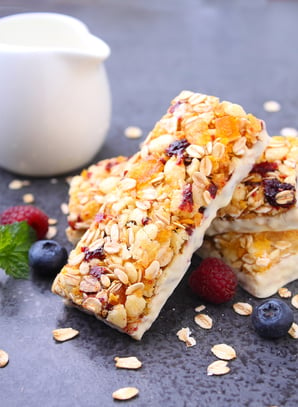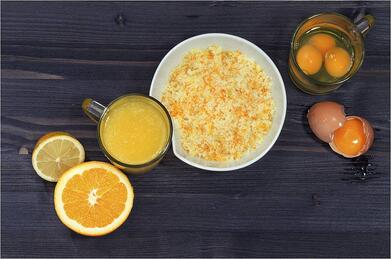 There are so many nutrition bars out there that I am sure it can be a challenge to pick one that is the best. So how do you know if the bar you are choosing is the healthiest option for you?
There are so many nutrition bars out there that I am sure it can be a challenge to pick one that is the best. So how do you know if the bar you are choosing is the healthiest option for you?
With anything, when it comes to your food and nutrition, the key is moderation and balance. You should be choosing a bar that you like the taste of and that works for your schedule and habits. The goal is to try to eat as many whole, fresh foods as possible and decrease the packaged foods with giant ingredients lists of things you might have trouble pronouncing. However, these bars can be a nice backup for snacks to keep in your purse, car, gym bag, or desk drawer for those times when you need fuel and don’t have other options.
Choosing a Nutrition Bar
Here are some good rules of thumb to follow when it comes to these convenient bars.
Protein: Choose one with at least 5 grams and no more than 15 grams. This will help keep you full and is what makes these bars have more staying power than a regular granola bar or candy bar. Too much protein will make the bar have an unpleasant taste, or more ingredients will be added to cover the added protein taste. Also, this bar is intended to be a snack to hold you over until mealtime, and not to replace the quality protein you should be getting from meals.
Fiber: Choose one with more than 3 grams. Fiber is another thing that will help keep you full, so choosing a bar with staying power will help keep you satisfied until your next meal.
Fat: Choose one with mainly heart-healthy fat. Check the label and make sure the saturated and trans fat content is low and the majority of fat is coming from mono or polyunsaturated fats like you would find in nuts.
Carbohydrates: Choose one with mostly whole grains and 15 grams or less of sugar. This can be tricky because a lot of bars have added sugar to make them taste better. Try to steer away from the ones that are a fancy candy bar and choose one that is lower in sugar.
The Most Nutritious Bars
Here are a few bars that meet these requirements:
Was your favorite not on the list, or did it not meet the requirements? Remember, if you are choosing a nutrition bar occasionally, it can fit into a balanced diet and complement your healthy eating.


 Whether you are traveling for business or for pleasure it typically means most meals are eaten out or on the go. This can be challenging to make the most balanced choices and keeping your eating on the right track. You want to try foods special to that region, you are busy and grabbing the first thing that sounds good, you don’t have access to a grocery store for more fresh foods can all be challenges while traveling.
Whether you are traveling for business or for pleasure it typically means most meals are eaten out or on the go. This can be challenging to make the most balanced choices and keeping your eating on the right track. You want to try foods special to that region, you are busy and grabbing the first thing that sounds good, you don’t have access to a grocery store for more fresh foods can all be challenges while traveling.
 Vitamin D…almost all of the 600 IU that are recommended daily. The canned tuna and sardines are an inexpensive way to get in seafood, heart healthy omega 3’s and 150 IU of Vitamin D per serving. Another bonus is the long shelf life if you haven’t been to the grocery store to get fresh protein choices.
Vitamin D…almost all of the 600 IU that are recommended daily. The canned tuna and sardines are an inexpensive way to get in seafood, heart healthy omega 3’s and 150 IU of Vitamin D per serving. Another bonus is the long shelf life if you haven’t been to the grocery store to get fresh protein choices.
 The
The  The countdown begins as the league’s top-ranked defense of the Seattle face the leading Denver offense on February 2nd. With the matchup set, there are no clear favorites this year, making this the must see game of the season. For football fans this means hours of what hopefully is a really great game. For food fans, this means a delicious feast to be shared among family and friends. If you are neither, well at least you can get a good laugh during commercials.
The countdown begins as the league’s top-ranked defense of the Seattle face the leading Denver offense on February 2nd. With the matchup set, there are no clear favorites this year, making this the must see game of the season. For football fans this means hours of what hopefully is a really great game. For food fans, this means a delicious feast to be shared among family and friends. If you are neither, well at least you can get a good laugh during commercials.
 It only comes around once per year, so why not indulge with dinner at the fair? Well some of your favorite fair foods might only be consumed once per year, but if you aren’t increasing the amount of exercise to go along with them, the extra weight gained can stick around for longer! Here are some of the more popular fair food items and how far the average person would need to walk around to burn it off!
It only comes around once per year, so why not indulge with dinner at the fair? Well some of your favorite fair foods might only be consumed once per year, but if you aren’t increasing the amount of exercise to go along with them, the extra weight gained can stick around for longer! Here are some of the more popular fair food items and how far the average person would need to walk around to burn it off!
 Currently one-third of Americans believe they should be cutting down on gluten in their diet (based on
Currently one-third of Americans believe they should be cutting down on gluten in their diet (based on  It's that time for another season of candy! Actually, none of these candies would be considered healthy, but some of them are definitely better than others. Plus, with all things, it is important to keep in mind the importance of moderation, even when digging through your Easter basket. Here is a rundown of some of the most popular Easter candy choices and what you would have to do in order to burn them off.*
It's that time for another season of candy! Actually, none of these candies would be considered healthy, but some of them are definitely better than others. Plus, with all things, it is important to keep in mind the importance of moderation, even when digging through your Easter basket. Here is a rundown of some of the most popular Easter candy choices and what you would have to do in order to burn them off.* By June 2013 only 46% of people will still be sticking to the resolutions they vowed to keep as the ball dropped and we said goodbye to 2012. A recent study showed that the three most popular resolutions are finding more family and friend time, increasing or starting an exercise program, and trying to lose weight. The tips below will help you stick to those resolutions so they will last all year long.
By June 2013 only 46% of people will still be sticking to the resolutions they vowed to keep as the ball dropped and we said goodbye to 2012. A recent study showed that the three most popular resolutions are finding more family and friend time, increasing or starting an exercise program, and trying to lose weight. The tips below will help you stick to those resolutions so they will last all year long.